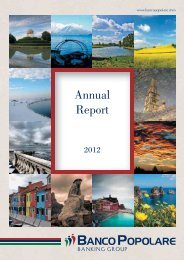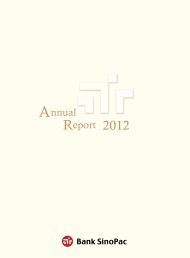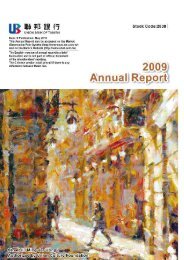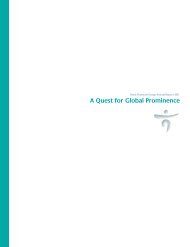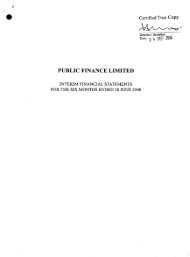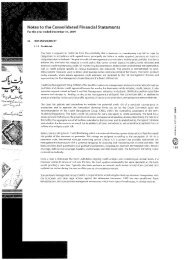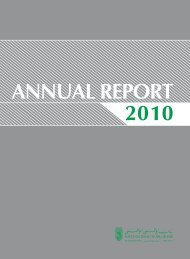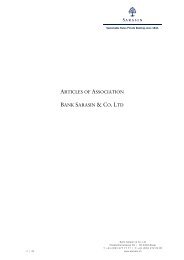Annual Report 2011 - Hong Kong Monetary Authority
Annual Report 2011 - Hong Kong Monetary Authority
Annual Report 2011 - Hong Kong Monetary Authority
You also want an ePaper? Increase the reach of your titles
YUMPU automatically turns print PDFs into web optimized ePapers that Google loves.
- The Risk Manager sees to it that the risk management<br />
guidelines and methods are incorporated in decisionmaking<br />
and operational processes. He monitors risk<br />
exposure and compliance with the relevant limits, and<br />
reports on risk status to the Bank/Group. Each Group<br />
entity has a Risk Control and Management section that<br />
reports regularly to the Risk Manager of the Bank.<br />
Interest rate and liquidity risks<br />
The liquidity risk is the risk that the Group might not be able<br />
to meet its present and future cash flow and collateral requirements,<br />
whether expected or unexpected, without harming its<br />
daily operations or financial situation. The interest rate risk<br />
resides in the vulnerability of the Group’s net worth or net interest<br />
margin to an adverse movement in market interest rates.<br />
It is not the Bank’s or the Group’s objective to take advantage<br />
of our ability to change due dates or to expose ourselves<br />
to the liquidity risk. We take a prudent approach to<br />
cash management by choosing short maturities and firstclass<br />
counterparties. Our emphasis is on safeguarding our<br />
commitments to clients, in normal and stress situations<br />
alike. We moreover seek to match resources to their use<br />
both short and long term.<br />
The risks attaching to liquidity and to interest rate positions/<br />
maturities are gauged by using the most up-to-date balance<br />
sheet management techniques and by tracking these<br />
items with dedicated software. An Asset and Liability Management<br />
Committee drafts and oversees the implementation<br />
of rules on managing liquidity, interest rate and forex<br />
risks. It is also responsible for optimising cash management<br />
and ensuring structural control of the balance sheet.<br />
Counterparty risk<br />
This is the risk that a client or counterparty bank might not<br />
be able to honour an obligation towards the Group.<br />
Counterparty banks<br />
The counterparty banks that the Group deals with are<br />
selected rigorously and kept under close scrutiny. Our<br />
exposure to them is monitored continuously by a team of<br />
controllers, and the limits that we have granted to each are<br />
updated periodically or in real time if so required by a deteriorating<br />
situation. To minimise the counterparty risk attaching<br />
to correspondent banks, we give preference to reverse<br />
repo agreements and to depositing cash directly with central<br />
banks. All the Group entities use the limits system and<br />
monitor the risk of counterparty concentration.<br />
Clients<br />
The credit facilities that we grant to clients are mainly shortterm<br />
advances secured by their investments and, less<br />
frequently, loans in connection with their business activities.<br />
Applications for these facilities are subject to stringent<br />
analysis, and the pledged securities are assigned a collateral<br />
ratio according to their liquidity, valuation, credit rating<br />
and diversification in terms of asset class and geographical<br />
spread. Daily monitoring of the client credit risk is handled<br />
by a special team that also administers the loans.<br />
Market risk<br />
This lies in the vulnerability of the Group’s financial situation<br />
to adverse swings in market prices and especially in the<br />
underlying value and implied volatility of currencies, equities,<br />
precious metals and commodities.<br />
Securities dealing on a propriety basis forms a very small<br />
part of the Group’s business. In currencies and precious<br />
metals we chiefly operate on behalf of clients and build only<br />
small nostro positions. The limits granted to traders are low,<br />
and their use of these is monitored constantly with software<br />
by separate risk management and internal control services.<br />
Operational risk<br />
This is the risk of loss that the Group would suffer owing<br />
to the inadequacy or failure of internal procedures, staff, IT<br />
systems or external occurrences.<br />
The Group entities have adopted a policy aimed at monitoring<br />
and mitigating the following operational risks inherent in<br />
wealth management:<br />
- internal and external fraud<br />
- negligence regarding confidentiality and/or banking secrecy<br />
protection requirements<br />
FINANCIAL REPORT CONSOLIDATED ACCOUNTS 75



